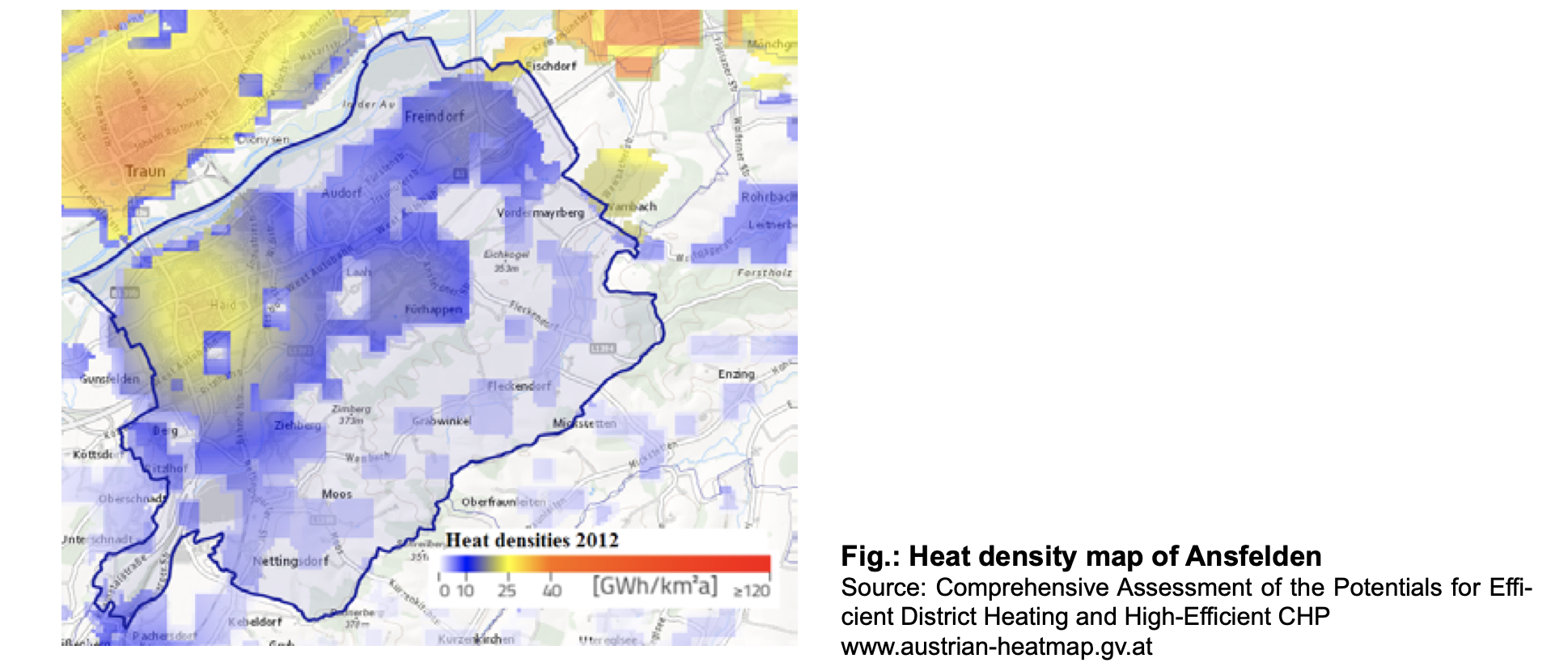Austria
2017
- Type : Energy planning
- Size : Local community
- Area : Residential
Environmental benefit
Renewable heating strategy for a new development area
Share
Austria
2017
- Type : Energy planning
- Size : Local community
- Area : Residential
Environmental benefit
Discover this use case online

The scenarios and policy assessments led to the following results:
• In the studied case, without policies, the cheapest option to supply heat is a biomass only network accompanied by a heat storage of 100 m3.
• The calculations showed that with additional heat costs of around +7 % (with subsidies) to +10.5 % (without subsidies), solar fractions of 15 % can be generated by installing solar thermal collectors and up to 42 % by installing solar PV that drives a heat pump. This could reduce the biomass demand by up to 40 %.
• When assuming considerably lower installation costs for solar thermal collectors (e.g. ground mounted instead of roof mounted collectors), the heat generation costs are similar to those of the biomass-only boiler for solar shares up to 25 %. Therefore, emphasis should be put on attempting to reduce investment costs for solar thermal collectors by installing bigger units and using synergies when building a new development area.
• Both solar thermal collectors and a heat pump + PV require additional investments. Certain conditions could make these options more interesting such as higher energy prices or running the heat pump on electricity purchased from the grid when excess electricity from the PV can be fed into the grid.
• The results of the analysis show that under certain conditions, higher shares of solar heat can be integrated at lower costs with the combination of central heat pump and PV than with solar thermal collectors.
Recommendations and possible solutions
For the new development area, the folowing policy recommendations should be considered:
• Using existing national and regional financial support schemes for DH network and RES Subsidies up to 50% of the total investment costs and low-interest rates are already available from the national and regional programs for investment into district heating network infrastructure and RES installations – including biomass boiler, solar thermal collectors and heat pumps
• An integrated planning approach can be enabled by:
– Providing free audits and advice to building owners within potential expansion areas
– Providing additional resources to the local urban development office
– Special marketing campaigns and promotional activities
– Including local housing associations and private renter in strategy development.
 R-ACES has received funding from the European Union’s Horizon 2020 research and innovation programme under grant agreement N° 892429
R-ACES has received funding from the European Union’s Horizon 2020 research and innovation programme under grant agreement N° 892429
The scenarios and policy assessments led to the following results:
• In the studied case, without policies, the cheapest option to supply heat is a biomass only network accompanied by a heat storage of 100 m3.
• The calculations showed that with additional heat costs of around +7 % (with subsidies) to +10.5 % (without subsidies), solar fractions of 15 % can be generated by installing solar thermal collectors and up to 42 % by installing solar PV that drives a heat pump. This could reduce the biomass demand by up to 40 %.
• When assuming considerably lower installation costs for solar thermal collectors (e.g. ground mounted instead of roof mounted collectors), the heat generation costs are similar to those of the biomass-only boiler for solar shares up to 25 %. Therefore, emphasis should be put on attempting to reduce investment costs for solar thermal collectors by installing bigger units and using synergies when building a new development area.
• Both solar thermal collectors and a heat pump + PV require additional investments. Certain conditions could make these options more interesting such as higher energy prices or running the heat pump on electricity purchased from the grid when excess electricity from the PV can be fed into the grid.
• The results of the analysis show that under certain conditions, higher shares of solar heat can be integrated at lower costs with the combination of central heat pump and PV than with solar thermal collectors.
Recommendations and possible solutions
For the new development area, the folowing policy recommendations should be considered:
• Using existing national and regional financial support schemes for DH network and RES Subsidies up to 50% of the total investment costs and low-interest rates are already available from the national and regional programs for investment into district heating network infrastructure and RES installations – including biomass boiler, solar thermal collectors and heat pumps
• An integrated planning approach can be enabled by:
– Providing free audits and advice to building owners within potential expansion areas
– Providing additional resources to the local urban development office
– Special marketing campaigns and promotional activities
– Including local housing associations and private renter in strategy development.
